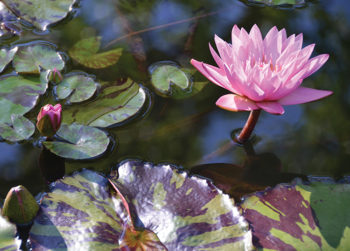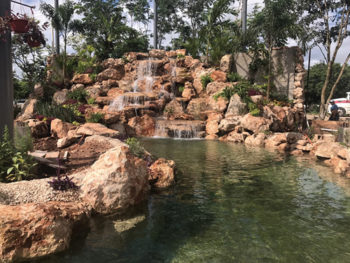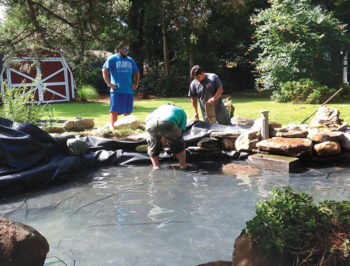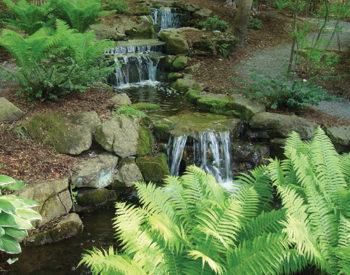
Just like in real estate, the location of a water feature is key. The most natural-looking man-made pond is one that could have been created naturally, given time and the interaction of weather, geology and gravity. The processes are always the same, though geology and terrain will vary. Water flows out from the side of a hill, usually at the boundary of pervious and impervious soils or rock, not out of the top like lava erupting from a volcano.
Here on Long Island, for example, water will collect in a sand layer above a clay bed, forcing its way out of the side of a hill where the layers are exposed. It cuts its way through softer soils until it hits a harder layer, creating a sunken path below the original grade. Water pools at a low point in the landscape, with a pond forming where the seepage rate of the soils below can’t keep up with the flow from the spring. When we imitate these processes, we create the best-looking water features.
Sometimes we are given the perfect site to work with, like this wooded hillside here on Long Island. All we had to do was to follow the original water flow down the slope when we built the stream, excavating into the hillside to mimic millennia of rain and erosion cutting a channel to the bottom.Make the Best of It
However, we are rarely given an absolutely ideal location. As contractors, we must make the best of the site we are asked to develop. Often, the requests of our customers are at odds with natural law, not to mention taste. I know I’m not the only contractor who’s been asked to create a massive rock waterfall 12 feet tall on a dead-flat property. As much as I might like to say I would never compromise my principles, I have indeed built tall cascades on flat ground 500 miles from the nearest natural feature. (See the photo at top right.) With any luck, folks will continue to ask me to build them.

But before I build anything, there are factors to consider that affect how well our features function after they’re built. Exposure to sun and wind, the absence or presence of plants — especially trees — near the feature, and the proximity to wild or public spaces will influence how we build and maintain our features. Then there are the wholly man-made challenges we may encounter — gas lines, power lines, water lines, cable and telephone wires, septic systems, dry wells, sprinklers and even the odd pet cemetery. (Don’t ever put a heavy collar on a toy poodle — ’nuff said.)
Location Checklist
I’d like to share with you the checklist I use to determine the best location for a feature to ensure it will be safe and easy to maintain before I decide how best to make it look more natural. Many are self-evident; most of you already do something similar.
First, check local codes | The view of the most beautiful feature in the world can be ruined if you need a 5-foot-tall fence with self-closing gates around it. (If it’s 18 inches deep or deeper in my county, that’s the law.) Even worse, you may be asked to modify or even remove it. Do the legwork and make sure you are proposing a feature you can legally build.

handrail for active, 80-year-young pond owner Lily, who insists on doing most of her own maintenance.
Next, note how sunlight travels across the area | Is it going to be in full sun all day? That might raise water temps and promote algae. Maybe you’ll want to plant to shade the western sun. Want waterlilies? Make sure you have six to eight hours of sun in the planting area. Using plants to control nutrients and algae growth? Make sure they’re in full sun if possible.
Always ask about strength and direction of prevailing winds | I built a lovely formal spillway on the wall of a courtyard in Merida, Yucatan, only to find out later that winter winds blow the water completely out of the basin for three to four months of the year. I will be rebuilding that water feature at cost. Winds also influence where debris will end up. Putting the skimmer on the far side of the pond from the waterfall won’t help if there’s a constant breeze blowing the debris in another direction. Also, breezy sites lose water at a much greater rate than protected areas, not only from splash and evaporation, but also from increased plant transpiration. Plants, like people, use more water on breezy days to protect themselves from windburn and dehydration.
Verify the direction and quantity of water runoff | As attractive as the idea of external water sources topping off the pond may be, the last thing you want is runoff. Messy organics, debris, sediments and the mess they leave are bad enough. Lawns and gardens may be contaminated not only with fertilizer, but fungicides, herbicides and pesticides as well, all of which wreak havoc on water features. On the other hand, think about using a first flush diverter to capture clean water from a nearby roof &151; a clean, green alternative to introducing chlorinated water via an automatic fill valve.

Think about the view | We all site our features so they can be appreciated from picture windows, living rooms, a bedroom, dining areas on decks, and even from the kitchen sink. (It makes doing the dishes that much more bearable, right?) Use or develop borrowed views of adjacent or distant landscape features to open up the apparent size of the feature or yard. Consider also the views you will want to block. Hiding infrastructure is one thing; keeping a backyard pond out of sight from a local park or kindergarten may keep it from becoming an attractive nuisance. Think also about the wildlife that might visit. Screening a pond from the view of hawks and herons is something we have to think about where I live (not to mention keeping out the deer and their sharp hooves).
Consider access | not only general access to the site for equipment and materials, but also to services such as electric, water and maybe even gas. Also consider how you will be restricting access, with fencing or plantings to keep people out or away from the feature. The design of the perimeter of ponds can restrict access to wading predators by using vertical walls at the edges that don’t provide easy entry to herons, egrets and raccoons, our biggest threats. (But remember the 4 Ws — Won’t Work With Weasels. Minks and otters don’t care what you do. Nothing stops them, especially the sea otters my friends in British Columbia tell me aboot.) On the other hand, I have been adding easy access in all my rebuilds and retrofits. I build stone steps so my customers and I can get in and out easily for maintenance and cleaning. Before you ask, I set the first step or shelf 18 inches deep with a solid handhold, so it’s safe for people but won’t work for herons and raccoons.
 Elevation is everything | Unless your customer wants a quiet, still waterlily pond, you’ll need water in motion, and that implies lifting it somehow. On flat sites, we plan on using the excavated soil to create a hillside rather than a bump. We’ll start the stream a quarter of the way down from the top, cutting into the hillside the way a natural stream would. Finally, we’ll create an illusion of a taller hill behind it, often the same way a diorama in a museum does. We’ll plant the rear slope of the hill with smaller evergreens and then plant larger trees behind them as a backdrop. On sloped sites, we want our pond toward the bottom of the slope, but we don’t want a pond at the very bottom, or we may have problems with runoff. Streams on natural slopes are beautiful, but it can be harder to build on sloped ground.
Elevation is everything | Unless your customer wants a quiet, still waterlily pond, you’ll need water in motion, and that implies lifting it somehow. On flat sites, we plan on using the excavated soil to create a hillside rather than a bump. We’ll start the stream a quarter of the way down from the top, cutting into the hillside the way a natural stream would. Finally, we’ll create an illusion of a taller hill behind it, often the same way a diorama in a museum does. We’ll plant the rear slope of the hill with smaller evergreens and then plant larger trees behind them as a backdrop. On sloped sites, we want our pond toward the bottom of the slope, but we don’t want a pond at the very bottom, or we may have problems with runoff. Streams on natural slopes are beautiful, but it can be harder to build on sloped ground.
Finally, call before you dig | Every year, otherwise smart, experienced contractors figure out exactly where gas and power lines are without calling for markout, and every year somebody dies. According to the Common Ground Alliance (CGA), over the past 20 years, utility hits have resulted in $1.7 billion in property damage, 1,906 injuries, and 421 deaths. There is no excuse not to dial 811 or the One Call Center at least two working days before digging. It’s fast; it’s free; and it’s the law. You avoid potentially huge fines if you do hit something. Plus, nobody dies. Do it!
Now that we’ve considered all that, we can concentrate on making a beautiful water feature.



Fantastic and necessary info by one of the BEST !!!!